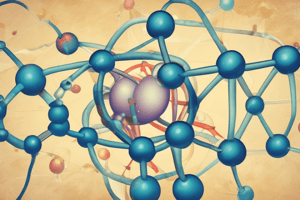Podcast
Questions and Answers
What type of bonding involves the sharing of electrons between atoms?
What type of bonding involves the sharing of electrons between atoms?
- Ionic bonding
- Metallic bonding
- Hydrogen bonding
- Covalent bonding (correct)
Which type of bond is formed when three pairs of electrons are shared between atoms?
Which type of bond is formed when three pairs of electrons are shared between atoms?
- Double bond
- Single bond
- Triple bond (correct)
- Dative bond
What do Lewis diagrams represent?
What do Lewis diagrams represent?
- The movement of electrons within an atom
- The structure of the atomic nucleus
- The chemical properties of an element
- The valence electrons and bonding between atoms (correct)
In covalent bonding, what happens when atoms share electrons?
In covalent bonding, what happens when atoms share electrons?
What type of bond involves one atom donating a lone pair to bond with another atom lacking electrons?
What type of bond involves one atom donating a lone pair to bond with another atom lacking electrons?
How do helium atoms behave when approached for bonding?
How do helium atoms behave when approached for bonding?
'Oxygen atom shares electrons with hydrogen atoms' exemplifies which type of bond?
'Oxygen atom shares electrons with hydrogen atoms' exemplifies which type of bond?
'Formed when two pairs of electrons are shared, as in O2' refers to which type of bond?
'Formed when two pairs of electrons are shared, as in O2' refers to which type of bond?
Why do atoms bond?
Why do atoms bond?
What is the role of valence electrons in bonding?
What is the role of valence electrons in bonding?
Why are noble gases considered stable?
Why are noble gases considered stable?
In the atomic model, where do valence electrons reside?
In the atomic model, where do valence electrons reside?
What determines whether atoms will bond or not when they approach each other?
What determines whether atoms will bond or not when they approach each other?
How does bonding affect the energy levels of atoms?
How does bonding affect the energy levels of atoms?
What drives atoms to mimic noble gases?
What drives atoms to mimic noble gases?
What is the fundamental concept for deciphering molecules and compounds?
What is the fundamental concept for deciphering molecules and compounds?
Which electrons play a key role in determining chemical behavior?
Which electrons play a key role in determining chemical behavior?
How do noble gases differ from other elements in terms of reactivity?
How do noble gases differ from other elements in terms of reactivity?
What type of bond occurs when both electrons shared in the bond come from the same atom?
What type of bond occurs when both electrons shared in the bond come from the same atom?
Which type of bond involves sharing two pairs of electrons between atoms?
Which type of bond involves sharing two pairs of electrons between atoms?
What does a Lewis diagram represent in terms of chemical bonding?
What does a Lewis diagram represent in terms of chemical bonding?
Which type of bond arises when three pairs of electrons are shared between atoms?
Which type of bond arises when three pairs of electrons are shared between atoms?
How do helium atoms behave when approached for bonding?
How do helium atoms behave when approached for bonding?
'Stabilizing the atoms in a lower energy state' mainly refers to:
'Stabilizing the atoms in a lower energy state' mainly refers to:
'Sharing of electrons between atoms' is a characteristic feature of:
'Sharing of electrons between atoms' is a characteristic feature of:
'Atoms share or transfer electrons to achieve stable configurations' is best associated with:
'Atoms share or transfer electrons to achieve stable configurations' is best associated with:
'Non-bonding pairs of electrons' can significantly affect the shape and reactivity of a molecule due to their role in:
'Non-bonding pairs of electrons' can significantly affect the shape and reactivity of a molecule due to their role in:
'Two pairs of electrons shared, as in HCl' typically refers to which type of bond?
'Two pairs of electrons shared, as in HCl' typically refers to which type of bond?
What is the primary reason why atoms bond?
What is the primary reason why atoms bond?
Which electrons are crucial in determining an atom's chemical behavior?
Which electrons are crucial in determining an atom's chemical behavior?
What occurs when two hydrogen atoms approach each other for bonding?
What occurs when two hydrogen atoms approach each other for bonding?
In atomic bonding, what do atoms aim to mimic for stability?
In atomic bonding, what do atoms aim to mimic for stability?
Which model forms the basis for our understanding of chemical bonding?
Which model forms the basis for our understanding of chemical bonding?
What results from the interaction between atoms when they approach each other?
What results from the interaction between atoms when they approach each other?
Why are noble gases considered less reactive compared to other elements?
Why are noble gases considered less reactive compared to other elements?
Which type of electron configuration do atoms aim to achieve through bonding?
Which type of electron configuration do atoms aim to achieve through bonding?
What is the primary function of Lewis diagrams in chemistry?
What is the primary function of Lewis diagrams in chemistry?
Which type of bond is crucial in the formation of certain ions and compounds?
Which type of bond is crucial in the formation of certain ions and compounds?
In chemistry, what does the presence of lone pairs in molecules primarily affect?
In chemistry, what does the presence of lone pairs in molecules primarily affect?
What drives some atoms to form multiple bonds with other atoms?
What drives some atoms to form multiple bonds with other atoms?
Which feature of covalent bonds distinguishes triple bonds from single and double bonds?
Which feature of covalent bonds distinguishes triple bonds from single and double bonds?
What is the main impact of having filled valence shells on helium's bonding behavior?
What is the main impact of having filled valence shells on helium's bonding behavior?
How do single bonds differ from double and triple bonds in covalent bonding?
How do single bonds differ from double and triple bonds in covalent bonding?
'Coordinate bonds' refer to a type of bond where:
'Coordinate bonds' refer to a type of bond where:
Why do atoms bond according to the text?
Why do atoms bond according to the text?
What determines whether atoms will bond or not when they approach each other?
What determines whether atoms will bond or not when they approach each other?
How do helium atoms behave when approached for bonding?
How do helium atoms behave when approached for bonding?
What type of bond arises when two hydrogen atoms approach each other?
What type of bond arises when two hydrogen atoms approach each other?
What role do valence electrons play in atomic bonding?
What role do valence electrons play in atomic bonding?
How do noble gases differ from other elements in terms of reactivity?
How do noble gases differ from other elements in terms of reactivity?
Which factor primarily drives atoms to mimic noble gases' stability in bonding?
Which factor primarily drives atoms to mimic noble gases' stability in bonding?
In atomic bonding, what happens to the energy state of atoms upon formation of a bond?
In atomic bonding, what happens to the energy state of atoms upon formation of a bond?




